
As a resident of New Mexico, I’ve seen firsthand the profound impact water scarcity can have on our communities. From parched landscapes to dwindling reservoirs, the effects of this pressing issue are impossible to ignore. But you know what they say – when life gives you lemons, make lemonade! Or in our case, when life gives us a dearth of freshwater, we find innovative ways to reuse what we’ve got.
Enter the concept of wastewater reuse for groundwater recharge – a game-changing approach that’s capturing the attention of water experts and sustainability enthusiasts alike. Let me tell you, this isn’t your average “let’s turn our sinks into mini-treatment plants” kind of deal. No, this is a high-tech, scientifically-backed solution that’s poised to transform the way we manage our precious water resources.
The Untapped Potential of Wastewater Reuse
Think about it – every time we flush, shower, or do the dishes, we’re sending gallons of water down the drain. And where does that water end up? In our wastewater treatment plants, of course. But here’s the kicker: that wastewater isn’t just a byproduct to be discarded; it’s a valuable resource waiting to be harnessed.
According to UNICEF, over 2 billion people worldwide live in areas with high or extremely high water scarcity. And as the climate continues to shift, these numbers are only expected to grow. That’s where wastewater reuse comes in – by treating and purifying this “used” water, we can replenish our depleted groundwater supplies and reduce our reliance on dwindling freshwater sources.
The Science Behind Wastewater Reuse
Now, I know what you might be thinking: “Reusing wastewater? Isn’t that, like, super gross?” But trust me, the science behind it is anything but icky. According to the research, advanced water treatment technologies can remove even the most stubborn contaminants, leaving us with water that’s cleaner than what comes out of our taps.
The process typically involves a multi-step approach, including:
1. Primary treatment: Removing larger solids and debris
2. Secondary treatment: Breaking down organic matter through biological processes
3. Tertiary treatment: Removing remaining contaminants through advanced filtration and disinfection
4. Groundwater recharge: Replenishing aquifers with the highly purified water
And the best part? This treated water can be used for a variety of purposes, from irrigating crops to supplying drinking water. It’s a win-win for both our communities and the environment.
Tackling Water Scarcity in New Mexico
Now, you might be wondering, “But how does this apply to my neck of the woods?” Well, my friends, New Mexico is at the forefront of this water conservation revolution. As Governor Michelle Lujan Grisham put it, “We have the time, resources, and technology to secure a strong water future” – and wastewater reuse is a crucial part of that plan.
In fact, the state has already made significant strides in this arena. Take the Produced Water Act of 2019, for example. This groundbreaking legislation has paved the way for greater reuse of water from the oil and gas industry, diverting it from disposal and putting it to work for the benefit of our communities.
But it doesn’t stop there. New Mexico is also exploring the use of brackish water – water that’s too salty for drinking but perfect for certain industrial and agricultural applications. By tapping into these alternative water sources, we can reduce the strain on our precious freshwater supplies and ensure a more sustainable future for all.
The Future of Wastewater Reuse in New Mexico
As we look ahead, the future of wastewater reuse in New Mexico is nothing short of exciting. The state has set ambitious goals, including reducing water consumption in rural and municipal communities by 10% through education and conservation incentives, and improving system-wide efficiency by 20% through infrastructure upgrades.
But perhaps the most innovative initiative is the creation of a State Strategic Water Supply – a program that will offer advanced market commitments to spur investment in new desalination and produced water treatment plants. By providing a guaranteed market for the treated water, the state is removing the risk for private companies and accelerating the development of these game-changing technologies.
And let’s not forget about the importance of groundwater monitoring and aquifer mapping. By better understanding the complex web of aquifers beneath our feet, we can ensure that our wastewater reuse and aquifer recharge projects are sited and managed in the most effective and sustainable way.
Embracing the Water-Resilient Future
As a resident of New Mexico, I can’t help but feel a sense of pride and optimism when I look at the strides our state is making in the realm of wastewater reuse and water conservation. It’s a testament to the ingenuity and forward-thinking of our leaders, and a shining example of what’s possible when we come together to tackle the challenges of our time.
But this is no solo endeavor. Each and every one of us has a role to play in securing a water-resilient future for our state. Whether it’s adopting water-saving practices at home, supporting the development of new water treatment technologies, or advocating for policies that prioritize sustainable water management, we all have a stake in the game.
So let’s roll up our sleeves, get our hands dirty (metaphorically, of course), and dive headfirst into this exciting new chapter of water stewardship. Who knows, we might just find that the key to solving our water scarcity woes was hiding in plain sight all along – right there in our own wastewater.
Alpha Wastewater is committed to being at the forefront of this water reclamation revolution, providing cutting-edge solutions and expertise to communities across New Mexico. By partnering with forward-thinking organizations like ours, you too can be a part of the movement towards a more sustainable, water-secure future. So what are you waiting for? Let’s get to work!